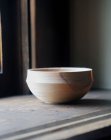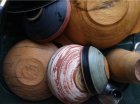In a sidebar on p135 of Richard Raffan’s The Art of Turned Bowls, he says, “The subtle marks of skillful tool handling can greatly enhance on object’s appeal.”
He’s talking about very subtle marks, but I also see a lot of bowls with pronounced tool marks intentionally left, and perhaps even enhanced. A lot of them were turned on pole lathes, but not all. I kind of admire the look as very rustic and handmade, which it seems a lot of people nowadays are looking for. They seem to sell really well. Attached are screenshots of a couple of examples from Instagram, with links below for credit.
I haven’t found a discussion of this on the forum, and much of the focus here is on removing tool marks and achieving a pristine finish. I wonder what you think, and if you ever make pieces this way.
https://www.instagram.com/p/CKhmbESDeHC/
https://www.instagram.com/p/CKw0-H4g-R2/
He’s talking about very subtle marks, but I also see a lot of bowls with pronounced tool marks intentionally left, and perhaps even enhanced. A lot of them were turned on pole lathes, but not all. I kind of admire the look as very rustic and handmade, which it seems a lot of people nowadays are looking for. They seem to sell really well. Attached are screenshots of a couple of examples from Instagram, with links below for credit.
I haven’t found a discussion of this on the forum, and much of the focus here is on removing tool marks and achieving a pristine finish. I wonder what you think, and if you ever make pieces this way.
https://www.instagram.com/p/CKhmbESDeHC/
https://www.instagram.com/p/CKw0-H4g-R2/


